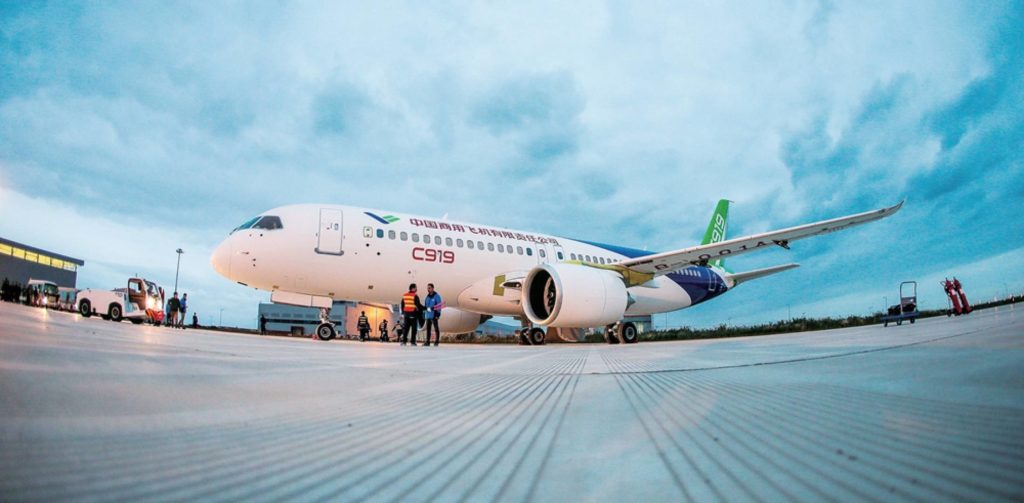25 Sep 2017
China Aviation Industry Newsletter 25 September
Airbus Inaugurates A330 Delivery Center in China
Airbus celebrated the opening of its A330 completions and delivery center (C&DC) in Tianjin, China, and handed over the first airplane delivered from the new facility to Tianjin Airlines. Airbus and its Chinese partners in the €150 million venture—the Tianjin Free Trade Zone Investment Company and the Aviation Industry Corporation of China (AVIC)—expect to see the facility outfit two airplanes per month by early 2019. The center sits adjacent to the site of the Airbus A320 final assembly line in Tianjin, where Airbus produces four airplanes a month primarily for the Chinese market. The A330 C&DC covers aircraft completion activities including cabin installation, aircraft painting and production flight test, as well as customer flight acceptance and aircraft delivery. Airbus trained some 150 Chinese staff members of the C&DC in Toulouse.
AviaAM Financial Leasing China Concludes $500 Million Aeroflot Project
AviaAM Leasing announced that its joint venture with the Henan Civil Aviation Development and Investment Company (HNCA) – AviaAM Financial Leasing China – has brought a $500 million-worth aircraft delivery project to a conclusion. Eight brand new aircraft were delivered to Aeroflot -Russian Airlines in total with the last aircraft – Airbus A321 – joining the carrier’s fleet on Thursday last week. The recent delivery of Airbus A321-211 (MSN 7782), equipped with CFM56-5 engines, took place at Airbus’ facilities in Hamburg, Germany on the 21st of September.
China to allow use of smartphones on aircraft
China’s aviation authority has set the ball rolling for allowing the use of smartphones onboard aircraft. The authority has, however, left it on the individual airline companies to take the final call on whether they want to allow the use of portable electronic devices (PEDs) on flights. The Civil Aviation Administration of China (CAAC) announced the fifth revision to government aviation regulations on Monday. The new regulations allow airlines to apply for permission for allowing passengers to use PEDs. At present, Chinese airlines do not permit use of PEDs during flights. The CAAC has also developed an approval process to deal with applications from carriers and assess whether they have the technological capabilities for offering call-making facilities without hindering the pilot’s navigation system.
Comac issues 20-year forecast for China aircraft demand
Chinese airlines will need 8,575 aircraft over the next 20 years, predicts Comac in a new market forecast released on 19 September. The airframer adds that of the total demand, single-aisle aircraft will account for 64% at around 5,488 units. Widebodies will account for 23% of demand at around 2,000, while turboprops will take up the rest. The total value of the aircraft required by Chinese carriers will come to around $121 billion.
Dublin-Beijing air route awaits China approval
A direct service between Dublin and Beijing has been approved by Hainan Airlines and the final all-clear from the Chinese government is pending, according to Dómhnal Slattery, the chief executive of aircraft leasing firm Avolon. The planned route has been in development for well over a year now.
More routes between Europe and China: Lucky Air to commence flights at Helsinki Airport
The role of Helsinki Airport as a hub between Europe and Asia strengthens as Chinese Lucky Air commences flights to Finland in winter 2018. Finavia, the Finnish airport operator, has invested heavily in serving Chinese passengers and improving the customer experience at Helsinki Airport. The route is expected to open on 17 January 2018, and it will be flown by wide-bodied Airbus A330 aircraft twice a week. Chengdu and Kunming are both Chinese metropolises. Once this route is opened, people living in these cities will have excellent connections to Finland and to the rest of Europe via Helsinki Airport. Lucky Air is part of the Chinese HNA Group.
Russia and China to Partner on Engine for New Widebody
Russia’s United Engine Corporation (UEC)signed a memorandum of understanding with China’s AECC Commercial Aircraft Engine Company calling for the joint development of a turbofan engine for the proposed new Russian-Chinese widebody known as the C929 in China and the LRWBA (long-range widebody aircraft) in Russia. The MOU, signed during Aviation Expo China in Beijing, calls for UEC—part of the Russian industrial conglomerate Rostec—and AECC to collaborate on research and competitive analysis, defining customer requirements, determining the engine’s architecture and deciding on its basic technical parameters.
Acumen Aviation © 25 September All Rights Reserved.









